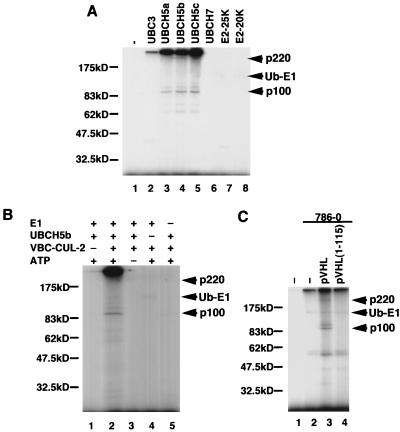Figure 1.
VBC-CUL-2 exhibits the E3 activity together with E2s of UbcH5 family. (A) The VBC-CUL-2 complex immunoprecipitated from HA-tagged WT-pVHL expressing 786–0 cells was incubated with recombinant E1, 32P-labeled ubiquitin, and ATP regeneration system at 37°C for 30 min in the presence of UBC3 (lane 2), UbcH5a (lane 3), UbcH5b (lane 4), UbcH5c (lane 5), UbcH7 (lane 6), E2–25K (lane 7), or E2–20K (lane 8), or in the absence of any E2 (lane 1). (B) In vitro ubiquitination reactions were performed as described in Materials and Methods, except for the followings: lane 1 lacks VBC-CUL-2, lane 3 lacks ATP regeneration system, lane 4 lacks UbcH5b, and lane 5 lacks E1. (C) Immunoprecipitates with anti-HA agarose beads from HA-tagged WT-pVHL expressing (lane 3), HA-tagged truncated pVHL (amino acids 1–115) expressing (lane 4), or parent 786–0 cells (lane 2) were subjected to the in vitro ubiquitination assay together with anti-HA beads alone (lane 1) in the presence of E1, UbcH5b, 32P-labeled ubiquitin, and ATP regeneration system at 37°C for 30 min. Reactions were stopped by adding 4× sample buffer and electrophoresed in 10% SDS/PAGE, followed by autoradiography.

